|
TrophyCatch Season 10 is going strong, and catches are still pouring in despite Florida now being well into the post-spawn period. Don't let the warmer weather fool you — a Florida trophy can show up any time of year. Current standings through this season are:
- 10,515 Lunker Club (8-9.9 lbs.)
- 2,627 Trophy Club (10-12.9 lbs.)
- 128 Hall of Fame (13+ lbs.)
- 13,270 TOTAL approved submissions to date
Dale Dew (in yellow shirt) caught the first pink-tagged bass out of Lake Griffin. He had only heard about the 10-Tag Celebration promotion that same morning.
The big news this quarter was the capture of two pink-tagged bass, part of the TrophyCatch 10-Tag Celebration. Dale Dew was the first angler to land a pink tag, crossing Lake Griffin off the list. He was awarded a $5,000 Bass Pro Shops gift card and $1,000 to shop at AFTCO at a special ceremony at Bass Pro Shops Tampa, during the Lowrance "Show Up and Shop" event. He had quite an interesting story to tell, and you can view the video of the ceremony here.
RJ Crawford caught the second pink-tagged bass, this one from Newnans Lake.
RJ Crawford was the second angler to score a pink tag, this one from Newnans Lake. He will receive the same prizing, and both RJ and Dale are now in the running for an additional $10,000 prize!
Will you be next? At this moment, 8 pink tags are still swimming across Florida, with at least one tag within day trip distance of almost anyone in the state. The current map is below, and will be kept updated at the 10-Tag web page. Bookmark the page and make sure you are following TrophyCatch Facebook for the latest pink tag news. Make sure you check the Featured Site which is also one of the 10-Tag waters, Lake Trafford, below. This promotion runs through September 30 and the end of Season 10, so now is the time to get out and get fishing!
Check the 10-Tag Celebration map for the tag location nearest you!
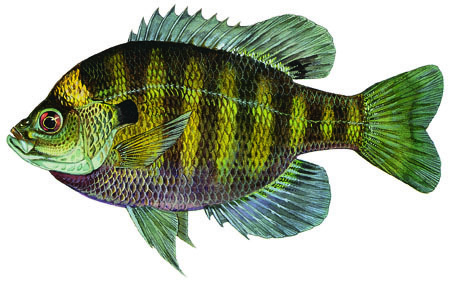
Size: This is one of the smallest of our popular game fish. The state record is 2.95 pounds. The Big Catch minimum qualifying sizes are 10” or 1.0 pound (see BigCatchFlorida.com).
Appearance: The bluegill is easily identified by the black spot on the gill cover and black spot on the end of the dorsal fin. The similar redear sunfish, as its name suggests, has a bright red border on the edge of the gill cover. The redear, along with other sunfish, lacks the bluegill's black dorsal fin spot.
Range & Habitat: Bluegill are common throughout Florida but are best known in lakes and ponds.
Behavior: Bluegill eat mostly insects and their larvae. Bluegill spawn throughout summer, congregating in large "beds." Anglers may find 30-40 shallow nests scooped out in sandy areas.
Sporting Quality: This willing fish is probably the best “starter” species of all for beginners, but will also continue to entertain anglers of any age or experience level. It will cooperatively and enthusiastically take live worms, crickets, grass shrimp, cut hot dogs, and doughballs. It will also attack any suitably small lure with abandon — recommended choices include beetle spins, jigs, spinners, tiny minnow imitations, small spoons, and most flies. Even a good-sized bluegill has a very small mouth, so always stick with small hook and lure sizes. While this fish rarely jumps, it puts up a very scrappy fight for its size, especially on ultralight tackle. Food quality is excellent, especially in the frying pan.
Fish illustrations by Duane Raver, Jr.
|
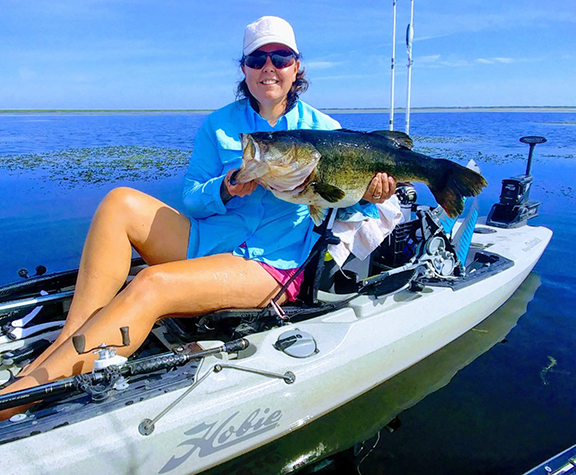 |
TrophyCatch angler Charlotte Johnson hefts a 10 lbs. 4 oz. bass caught while kayaking Fellsmere Reservoir
Kayaking has become one of the fastest-growing industries in the sporting world. These craft are versatile, economical, and just plain fun. In addition to providing a sport in and of itself, the kayak can be an incredible tool for better angling. Check the tips below if you have been thinking of taking the plunge.
Cost
There’s never been a better time to buy. Kayaks have become very popular in recent years, meaning that more manufacturers are making them and prices for an entry-level kayak are even lower than they used to be. Standard kayak models start at a low of about $250, but you’ll want to spend more for a fishing kayak that comes complete with rod holders and other angling amenities—expect to pay from $300 on up to well over $1,000 depending on features. You’ll also be buying a double-bladed kayak paddle, which will run you $50-100 or more. Most kayaks don’t include a padded seat, and you’ll probably want one; add another $50-75. Yes, the tab is adding up pretty quickly, but for an entry-level rig you’re still well under what the cheapest johnboat and trolling motor will cost you. Smaller accessories, such as a light anchor and—of course!—a life vest, you may already own if you’re a boater.
A kayak is a very personal purchase, and you should buy from a vendor that will allow an exchange if you don’t like the way the craft fits you or how it performs in the water. Some kayak shops are near water and will let you try before you buy. Keep in mind that you’ll need a way to transport your kayak, if you can’t just throw your new purchase in the pickup and head for the lake. A good roof rack setup or trailer may cost you more than your kayak, but a kayak is still one of the most economical boating options out there.
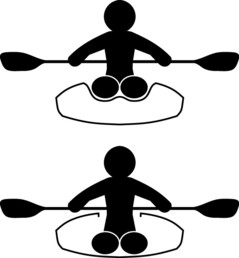
Sit-on-top versus sit-inside
There are two basic kayak types. A sit-on-top kayak is a sealed hollow shell with molded seating on top to accommodate the paddler. It’s easy to get in or out of, a major plus if you plan to kayak-and-wade. The kayaker sits above the waterline, which increases visibility and casting distance, but leaves the kayaker exposed to waves and splashing. Storage space is mostly open to the elements, but is easily accessible. However, there will probably also be one or two watertight hatches that allow dry storage inside the kayak shell. Note the size and location of the hatch openings, as these will limit what you’ll be able to fit inside and whether you’ll be able to reach them from the kayak seat. Water that splashes into the kayak drains out through scupper holes, which can be plugged to prevent water ingress, if you’ll be on calm water.
A sit-inside kayak is self-descriptive: the paddler sits inside a cutout in the open hull. Add a waterproof apron, and the paddler is pretty well protected below the waist from waves and water. The angler is sitting at the waterline, and the lower center of gravity may provide a more stable ride but slightly limited visibility and casting distance. The open hull provides plenty of fairly dry inside storage in front of and behind the kayaker. However, this internal storage is not as easily accessible, and entering and exiting the kayak is not nearly as easy. Generally, the sit-inside design is a good choice for river or ocean kayaking. However, most stillwater anglers prefer the in-and-out convenience offered by the sit-on-top design.
|
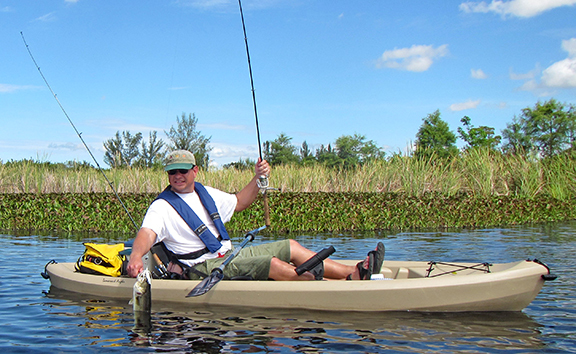 |
Fishing Kayaks
The simplest thing that defines a “fishing kayak” is the presence of rod holders. A fishing kayak will also usually be wider than standard kayaks—around 30” or so—and therefore more stable. It may have extra storage features, like molded in tackle trays or even a baitwell. Note that you can add after-market rod holders to most kayaks, but you’re better off starting with a fishing kayak, mainly for the added stability. A wider kayak won’t cut through the water as quickly as a standard model, but you’ll be able to cast, set the hook, and land frisky fish without feeling like you’re about to take a spill at any moment.
Length & Weight
Length is important. A longer kayak will travel faster and more efficiently (and have more storage space), but weigh more to load and carry—especially important if you’re cartopping or portaging. Twelve to thirteen feet is a popular range for saltwater anglers, and will provide a roomy and stable freshwater fishing platform too. However, if portability is important, look hard at kayaks ten feet or less in length. My ten-footer is a lightweight at exactly fifty pounds, but I’d still swear it’s half full of water when I hoist it back onto my roof racks at the end of the day. The weight is much easier to handle if you’re securing your craft to something below shoulder level, like a pickup bed or trailer. A kayak cart can also be a big help moving your boat from car to water (more on that later). Long story short, consider weight a critical factor based on how you’re transporting your kayak.
Next issue will look at specific kayak accessories.
Size: 1,500 acres
Location: Collier County
Description: Lake Trafford is Florida's largest natural lake south of Lake Okeechobee. Aquatic vegetation at Lake Trafford consists mainly of cattail, eelgrass, and planted bulrush. Game fish species present in the lake include largemouth bass, black crappie, bluegill, redear sunfish, and brown bullheads. Access to Lake Trafford is mainly by boat. However, there is a small county park located on the lake that provides some bank access as well as a public fishing pier. Lake Trafford Marina and the park both have public boat ramps. Services available from the marina include boat rentals, guide service, airboat tours, and bait and tackle. Anglers wanting the most current lake conditions can contact the Lake Trafford Marina at 239-657-2401.
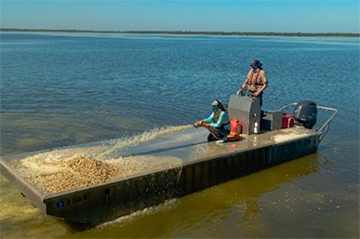
Lake Trafford experienced several large fish kills in the 1990s and 2000s, resulting in a major cooperative lake restoration and enhancement program by the Florida Fish and Wildlife Conservation Commission, Collier County, and the South Florida Water Management District - Big Cypress Basin. Project activities included a major dredging and muck removal operation, bass stocking, and native vegetation plantings. FWC staff and partners continue restorative efforts at the lake, such as gravel bed fish attractors that were installed in the lake in 2020 to provide spawning and foraging substrate for native game species.
|
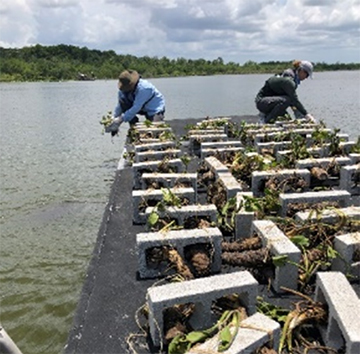
FWC has also continued planting native vegetation (spatterdock, bulrush, eelgrass) and stocking largemouth bass fingerlings (~200,000 since 2019) at the lake to provide habitat for native fish and allow bass populations to recover. The Division of Freshwater Fisheries Management has received funding from the Fish and Wildlife Foundation of Florida (via proceeds from the “Conserve Wildlife” license plate and donations by Bass Pro Shops through the Foundation) to produce native mussels at the Richloam Fish Hatchery that will be stocked in Lake Trafford to restore native mussel populations and potentially improve water clarity at the lake.
|
Lake Trafford restoration efforts continue, and the lake still provides a quality largemouth bass fishery with a total of 18 submissions of trophy bass (8+ pounds) to TrophyCatch, FWC's trophy bass catch, document, and release program. The largest bass submission from Lake Trafford was 10 lbs. 7 oz. and was caught in June 2017. It’s also a great time to go bass fishing at the lake with the opportunity to catch one of the 10-Tag Ba$$, a pink-tagged trophy bass swimming in the lake worth at least $6,000 in prizes! To be eligible, the bass must be caught and correctly submitted by September 30, 2022. The lake also attracts anglers for its black crappie fishing with catch rates of 1.57 fish per hour observed in the 2021 creel survey. Lake Trafford continues to be a great example of the importance and success of intra- and inter-agency cooperation by FWC staff to restore the lake and enhance the fishery.
Catch and submit this pink-tagged bass in Lake Trafford for at least $6,000 in prizes!
Understanding fish includes knowing the world they live in, both the physical world of lakes and ponds and the biological world of the plants and animals they share their environment with. Among these, invertebrates (animals with no backbone) play a critical role. They are not only vital forage for most species of fish, but also an integral part of the biological community. Below are some of the most common species. A few of these make great bait, but all will add to your knowledge and appreciation of the world fish inhabit.
Crayfish: (To 5”) Color ranges from red to brown to green. This common crustacean is well-known as a good bait for largemouth bass. The pincers can draw blood, however, so handle with care when using “crawdads” for bait. The egg-bearing female can be told instantly because she anchors the small, black eggs beneath her tail. Crayfish have nineteen pairs of appendages including antennae, legs, claws, and swimmerets! Note: There are no seasons, gear, bag or size limits for freshwater crayfish, and neither a recreational nor commercial license is needed. It is illegal to take Florida’s state-listed crayfish (Panama City, Sims Sink and Black Creek crayfishes) and all cave-inhabiting crayfish. |
|
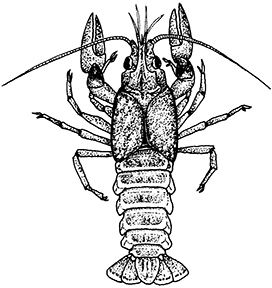 |
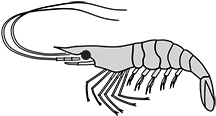 |
|
Grass shrimp: (To 1 ½”) This greenish, semi-transparent crustacean is very common. It is usually found closely associated with vegetation of some kind, often shoreline grasses. Like the crayfish, a female anchors her eggs beneath her tail. This is a prime panfish bait that, despite its small size, may also draw the interest of passing largemouth bass. |
Amphipod: (Less than ¼”) This gray, near-microscopic crustacean is common in bottom sediments and some vegetation (especially the submerged roots of water lettuce and water hyacinth). When removed from the water, it jumps around erratically. |
|
 |
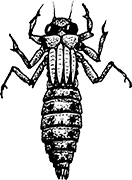 |
|
Dragonfly nymph: (To 1 ½”) This insect is usually green or brown in color. The larval form (like the adult dragonfly) is predaceous and will bite if given the opportunity. The body is thicker and rounder than the damselfly’s (below) and lacks the three “tails." Dragonfly nymphs can actually use a form of jet propulsion by expelling water quickly from the back of the body to “jet” forward if alarmed. |
Damselfly nymph: (To 1”) Usually green or brown. Look for the three feathery “tails”, which are actually breathing structures similar to gills. This is the larval form of the adult damselfly. |
|
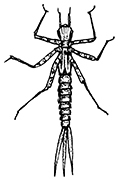 |
 |
|
Water bug: (To 2 ½”) This diverse group of insects comes in a wide variety of shapes and sizes. They are usually green, brown, or black. Most are highly predatory. The small, bright green water bugs in particular (called “alligator fleas” locally) have a strong, stinging bite—if one gets you, you’ll definitely take notice! Males of some species may be found carrying eggs cemented to their backs (for protection) by the female. These insects may fly from the water at night and are attracted to lights—sometimes providing an unexpected visitor to the front porch! |
Water strider: (To ¾”) This small, delicate bug is found on the water rather than in it. It usually occurs in groups that stay closely together as they skate erratically across the water’s surface. Usually black or brown in color. |
|
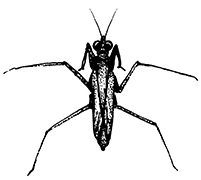 |
 |
|
Whirligig beetle: (To 1”) This shiny black beetle skims rapidly on top of the water’s surface in tight circles, lending it its name. It is often found in groups, and the overall effect on the observer can be dizzying! |
To contact the Florida Freshwater Angler, email John Cimbaro. Fish illustrations by Duane Raver, Jr. and Diane Rome Peebles.
|